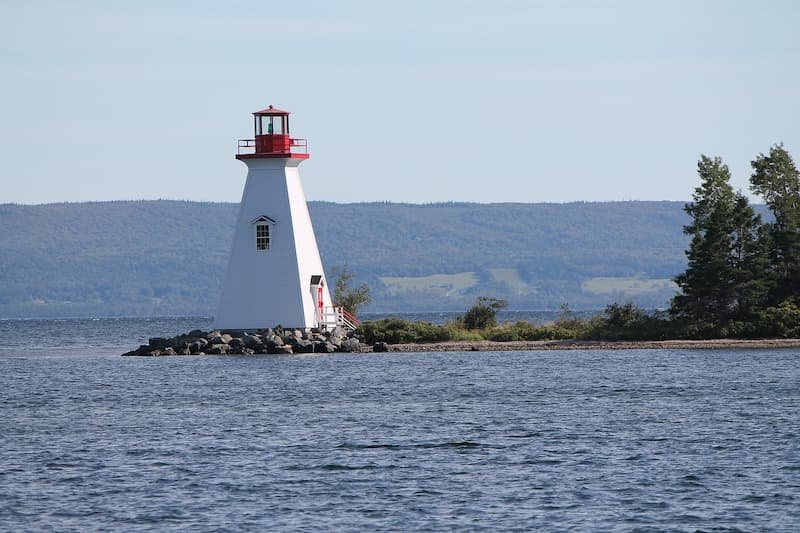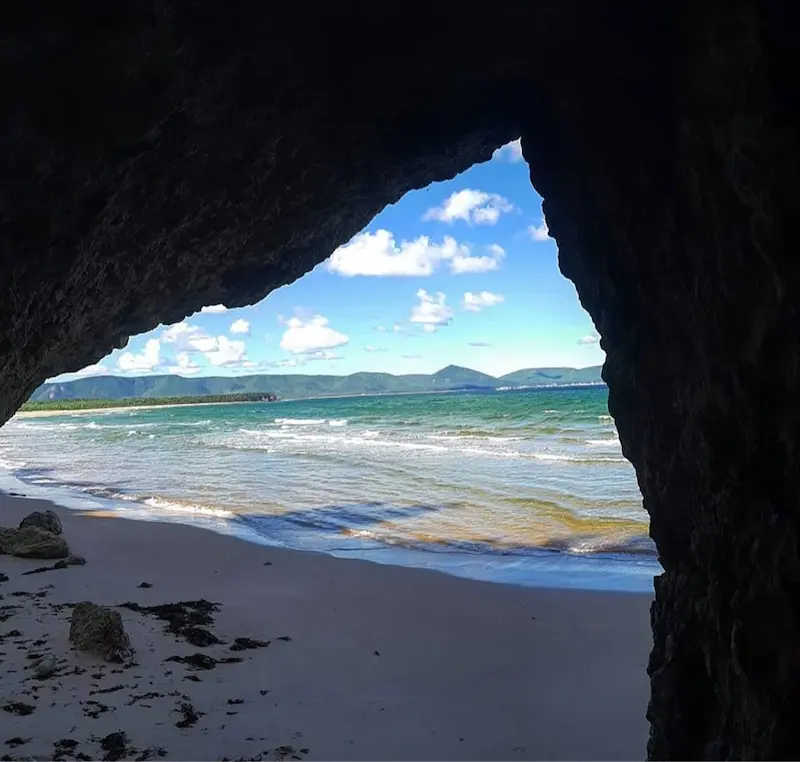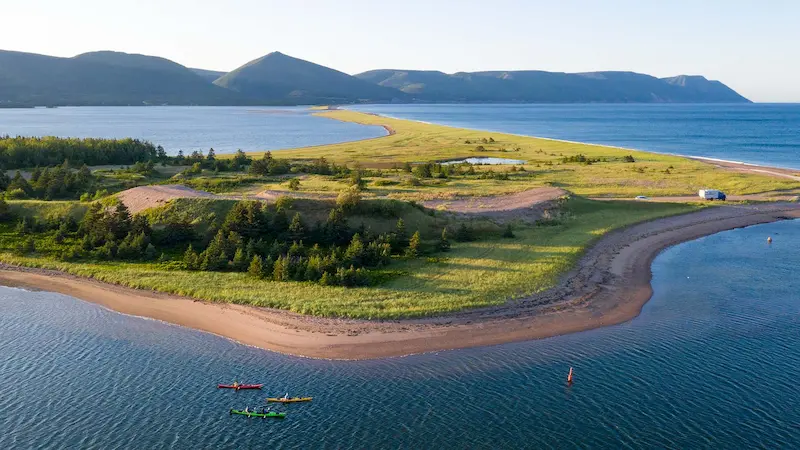- Cabot Trail Route Map and Distance
- What is the Best time to visit Cabot Trail?
- Cabot Trail Stops and Highlights
- Cabot Trail attractions & things to do on the Cabot Trail
- Cape Breton Highlands National Park
- Skyline Trail
- Acadian Cultural Experiences in Cheticamp
- Whale Watching Tours
- Ingonish Beach
- Golfing at World-Class Courses
- Alexander Graham Bell National Historic Site in Baddeck
- Enjoy Local Seafood and Cuisine
- Visit the Artisan Shops and Galleries
- Take Part in Seasonal Festivals
- Where to eat? Best Cabot Trail Restaurants
- The Rusty Anchor Restaurant in Pleasant Bay
- The Purple Thistle Dining Room at The Keltic Lodge, Ingonish
- The Dancing Moose Cafe, Birch Plain
- The Red Shoe Pub, Mabou
- The Coastal Restaurant & Pub, Ingonish
- Baddeck Lobster Suppers, Baddeck
- The Bite House, Baddeck
- Meat Cove Campground & Oceanside Chowder Hut, Meat Cove
- Le Gabriel Restaurant & Lounge, Cheticamp
- Neil's Harbour Chowderhouse, Neil's Harbour
- Final travel tips when visiting Cabot Trail
Embark on the ultimate Canadian road trip! Explore the breathtaking Cabot Trail, renowned for its scenic beauty and unforgettable vistas. This is the ultimate guide (updated April 2025) to prepare your road trip on Cabot Trail.
Nestled in the heart of Nova Scotia, Canada, the Cabot Trail offers a journey unlike any other, a blend of stunning natural beauty, vibrant cultures, and unforgettable adventures. As you embark on this iconic road trip, you’re not just driving on a highway; you’re weaving through a tapestry of breathtaking landscapes that showcase the best of Canada’s natural splendor.
The best place for road trips is Canada. Here, all the popular routes are unique and, unlike similar routes in the USA, more comfortable, enjoyable, and safe. The Cabot Trail certainly needs to be highlighted among the many options available to travelers. Let’s explore this route together and understand why it is so popular.
By choosing to explore this route with a rental car, you unlock a treasure trove of experiences, allowing you the freedom to pause wherever the beauty of Canada calls you the loudest. The Cabot Trail isn’t just a journey; it’s an invitation to connect with the wild, untamed beauty of Canada, all at your own pace. Imagine driving along cliff-top roads where the Atlantic Ocean crashes against age-old rocks below, then delving into the heart of Cape Breton Highlands National Park, where every turn reveals panoramic vistas or a hidden glen bathed in the soft light of the afternoon sun.
Cabot Trail Route Map and Distance
The Cabot Trail is located in Nova Scotia, on Cape Breton’s island. The highway you’ll be driving on stretches along the Atlantic coast, so you’ll always have a beautiful view outside your window. The road surface quality here is maintained at the highest possible level, making driving an enjoyable experience. It doesn’t matter whether you use a new car or one purchased at the Copart Lexington East auction.
The Cabot Trail, a winding marvel that stretches approximately 298 km (185 miles), encircles the better part of Cape Breton Island, taking you through a scenic wonderland of rugged coastlines, lush valleys, and highland peaks that reach towards the skies. It will take at least two days to complete. This is because, throughout the trip, you will make many stops to photograph, observe wildlife, and explore local attractions. Find below the Cabot Trail Route Map and Itinerary.
Need to rent a car in Nova Scotia?
Click here to book you car on Cape Breton’s island and enjoy drivint the Cabot Trail.
What is the Best time to visit Cabot Trail?
Deciding on the best time to visit the Cabot Trail is like choosing between a palette of vibrant colors, each offering its unique shade of beauty and adventure. This magnificent journey through Nova Scotia’s splendor can be experienced year-round, but to truly capture the essence of this iconic trail, understanding the seasonal landscapes and activities is key.
Visiting in Summer
Summer, stretching from June to August, is the peak season for exploring the Cabot Trail. With temperatures comfortably warm, usually ranging from 20°C to 25°C (68°F to 77°F), this season invites travelers to fully embrace outdoor activities. Hiking trails through Cape Breton Highlands National Park are at their most accessible, offering clear paths to breathtaking vistas. Summer also brings a burst of cultural vibrancy with festivals and events celebrating Celtic and Acadian heritage, making it a perfect time for those eager to immerse themselves in the local culture.
Visiting in Fall
Arguably the most picturesque season on the Cabot Trail is fall, particularly from late September through October. The landscape transforms into a dazzling display of autumnal hues, with forests ablaze in reds, oranges, and yellows. The cooler temperatures, ranging from 10°C to 20°C (50°F to 68°F), make it ideal for hiking and sightseeing. Additionally, fall marks the season for the Celtic Colours International Festival, an event that draws visitors from all over to celebrate Nova Scotia’s rich musical and cultural heritage against the backdrop of the fall foliage.
Visiting in Spring
Spring, from April to June, is a season of awakening along the Cabot Trail. While the weather can be unpredictable, with temperatures varying from 1°C to 17°C (34°F to 63°F), the melting snow reveals fresh greenery and blooming flowers, painting the landscape with vibrant life. This is a great time for those looking to experience the trail’s natural beauty without the summer crowds, though some attractions may have limited hours early in the season.
Visiting in Winter
For the adventurous at heart, winter on the Cabot Trail (December through March) offers a unique perspective of the landscape, blanketed in snow and offering a serene, quiet beauty. Temperatures can drop below freezing, but for those prepared for the cold, winter sports like snowshoeing and cross-country skiing in the highlands offer exhilarating experiences. The winter months also tend to be less crowded, providing a more intimate experience of the trail’s majestic beauty.
In conclusion, the best time to visit the Cabot Trail depends on what you’re looking for. For warm weather and outdoor activities, summer is ideal. For stunning visuals and cultural events, consider fall. Spring offers a quieter exploration of emerging life, and winter presents a bold, adventurous spirit with its snowy landscape. Each season on the Cabot Trail has its charm, ready to welcome travelers into its embrace.
Cabot Trail Stops and Highlights
Embarking on the Cabot Trail journey offers an array of starting points, each with its unique charm and convenience. Whether you’re flying into Nova Scotia or driving from another province, deciding where to begin your adventure on this scenic loop can set the tone for your entire trip. Here’s a guide to help you choose the perfect starting point for your exploration of the Cabot Trail.
Baddeck

The first stop on the route should be Baddeck, the Heart of Cape Breton. This small village attracts attention with its architectural attractions. There is a unique wooden church of St. Peter and John, built at the end of the 19th century, several historically significant houses, and many other buildings over 100 years old. Having reached the shore of the Atlantic Ocean on foot, you will be able to see the ancient lighthouse on the neighboring island.
Baddeck will also be of interest to lovers of various delicacies. Residents will gladly treat you to multiple delicacies and aromatic homemade cakes. If you’re traveling the Cabot Trail in the fall, Baddeck is home to an annual music festival that brings together performers worldwide.
St. Anns
Continue your road trip along the Cabot Trail in St. Anns. This place is located on the shore of the bay of the same name and is an excellent tourist attraction. Here, you can see the magnificent landscapes of Nova Scotia and many unique attractions. In addition, everyone can visit the Gaelic College of Celtic Arts and Crafts territory.
This educational institution has a history of almost 90 years, during which many famous personalities involved in preserving Gaelic culture worked there. The college is housed in a historically significant building, attracting travelers’ attention and becoming a popular subject captured in their photographs.
Ingonish
As you approach the route’s endpoint, you should turn into Ingonish. This town is known for its numerous tourist sites, each worthy of your attention. The main one is Breton Highlands National Park.
It abounds in various natural attractions, the beauty of which cannot be described in words. There are mountains, rivers, waterfalls, forests and plains. It is within the national park that the highest point in Nova Scotia is located. It is named White Hill and rises 533.5 m (1,750 ft) above sea level. If you love nature and want to stay here longer, walk around the park. For these purposes, 26 routes have been laid, most of which will lead you to some attraction (for example, to one of the stunning waterfalls). Ingonish also offers plenty of more traditional activities. You can play on the golf course, visit the ski center or the famous Keltic Lodge Hotel here.
South Harbour

South Harbour offers a tranquil escape into nature’s embrace. This hidden gem is a haven for those seeking serenity away from the bustling tourist spots.
With its pristine sandy beaches, sheltered by a narrow inlet that gives the area its name, South Harbour is an idyllic spot for kayaking, paddleboarding, or simply soaking in the peaceful surroundings. The area is surrounded by lush forests and rugged coastal landscapes, making it a perfect base for exploring nearby hiking trails or enjoying a picnic with a view.
Whether you’re a nature lover, an adventure seeker, or someone looking to unwind in a picturesque setting, South Harbour provides a gentle reminder of the quiet beauty that Cape Breton Island has to offer, making it a must-visit spot along or near your Cabot Trail journey.
Pleasant Bay
Moving further along the route, you will end up in Pleasant Bay. This unique place is known throughout the world, as everyone has the opportunity to watch whales here.
These giant mammals often approach the shore, where they can be seen with the naked eye. If you don’t see whales, go to the nearby forest. There, you will meet a variety of birds, hares, and other living creatures that are safe for humans.
Walking for hours can take a lot out of you, so try the local fish, lobster, crab, and other delicacies to replenish your energy reserves. After a delicious lunch or dinner, you can head to the next point on the Cabot Trail.
Dingwall and Cape North Area

A road trip along the Cabot Trail isn’t complete without going past Cape North. This cape northeast of Cape Breton is a unique natural attraction famous throughout Canada. It will be ideal for a family photo shoot, quiet, natural relaxation, and other pleasant activities.
Cape North also has its calling card. It is the lighthouse of the same name, erected in 2010. It replaced an outdated, similar building, which had been demolished several years earlier. If you have the opportunity, be sure to wait until sunset. This event has a unique appeal in Cape North and will not leave any traveler indifferent.
Visiting Dingwall is a must when driving through the Cape North area. This small fishing village is impossible to pass by. It is home to about 600 people who fish and develop the tourism industry. There is everything you need for the latter, from beautiful landscapes to architectural attractions.
The leading historical site of Dingwall is St. Joseph’s Church. It was built at the beginning of the 20th century and restored after a fire in the 80s. Also, travelers can visit the museum in this village and see the lighthouse on the island of St. Paul. For those who would like a less active holiday, one can visit one of the residents’ houses. After a visit like this, you will understand precisely what Dingwall hospitality means.
Chéticamp

This Nova Scotia community should be the second place you should visit when traveling by car. On the western side of Cape Breton Island lies Cheticamp, a vibrant Acadian fishing village that serves as another fantastic starting point for the Cabot Trail. Known for its rich Acadian culture, Cheticamp offers visitors a glimpse into the local heritage through its music, language, and crafts.
Here, you will have the opportunity to have a short beach holiday on the ocean. This place is replete with popular tourist sites that create comfort and allow you to have a good time. Not far from the beach is a miniature golf course where everyone can join the game or watch the players. You can enjoy the beautiful scenery between strokes, which is especially beautiful during sunset. Cheticamp also has several architectural attractions. The most exciting objects are St. Peter’s Cathedral and some residents’ houses.
Inverness
And to conclude the road trip, you can visit Inverness. Located on the west coast of Cape Breton Island, it is a captivating town that beckons visitors with its rich history, stunning landscapes, and warm community spirit. Once a thriving mining town, Inverness has transformed into a destination celebrated for its beautiful beaches, renowned golf courses, and vibrant cultural scene.
The town’s miles of sandy coastline, including the popular Inverness Beach, offer breathtaking views of the Gulf of St. Lawrence, making it a perfect spot for beachgoers and sunset watchers. For golf enthusiasts, Inverness is home to Cabot Links and Cabot Cliffs, two of the world’s most acclaimed golf courses, providing a unique blend of challenging play and spectacular ocean vistas.
Beyond its natural beauty and recreational offerings, Inverness is rich in cultural heritage, with a lively music scene and events that showcase the town’s Gaelic and Acadian roots. Whether you’re strolling along the boardwalk, exploring local artisan shops, or enjoying fresh seafood, Inverness is a charming town that embodies the heart and soul of Cape Breton Island, making it an essential stop on any Cabot Trail adventure.
Cabot Trail attractions & things to do on the Cabot Trail
The Cabot Trail, a scenic highway winding through Nova Scotia’s Cape Breton Island, offers an array of unforgettable experiences and attractions. Whether you’re an outdoor enthusiast, a history buff, or someone looking to soak in the natural beauty and culture of the area, there’s something for everyone along this iconic route. Here are some highlights and must-do activities on the Cabot Trail:
Cape Breton Highlands National Park
Spanning the northern section of the trail, this national park is a treasure trove of natural beauty. With over 26 hiking trails, ranging from easy strolls to challenging treks, visitors can explore stunning landscapes, from rugged cliffs and deep river canyons to lush forests and highland plateaus. Keep your eyes peeled for moose, eagles, and other wildlife.
Skyline Trail

Perhaps the most famous hike within Cape Breton Highlands National Park, the Skyline Trail offers breathtaking views of the Gulf of St. Lawrence and the chance to witness the majestic highland scenery from above. This relatively easy hike culminates in a dramatic headland overlooking the ocean, providing perfect photo opportunities, especially at sunset.
Acadian Cultural Experiences in Cheticamp
Cheticamp, a vibrant Acadian fishing village, offers a rich cultural experience with its lively music, traditional crafts, and delicious Acadian cuisine. Visit the local museums, attend a live ceilidh (a traditional Gaelic social gathering), and explore artisan shops for unique souvenirs.
Whale Watching Tours
The waters off Cape Breton are a haven for whales, especially from May through October. Several operators offer whale-watching tours, providing the opportunity to see these magnificent creatures up close. Common sightings include minke, pilot, and humpback whales, along with dolphins and seals.
Ingonish Beach
This beautiful beach is a perfect spot for relaxation and recreation. With its fine sand, clear waters, and scenic backdrop, Ingonish Beach offers a refreshing stop for swimming, picnicking, or simply enjoying the sun. The nearby Keltic Lodge Resort & Spa provides luxurious accommodations and dining options.
Golfing at World-Class Courses
Cape Breton Island is renowned for its golf courses, with Cabot Links and Cabot Cliffs in Inverness being among the top-rated in the world. These courses offer not only challenging play but also spectacular views of the ocean and landscapes.
Alexander Graham Bell National Historic Site in Baddeck
Discover the life and inventions of Alexander Graham Bell in this fascinating museum located in Baddeck. Exhibits showcase Bell’s work in aviation, communication, and marine engineering, providing insight into the mind of a genius.
Enjoy Local Seafood and Cuisine
The Cabot Trail is a foodie’s paradise, offering fresh seafood and local delicacies. From lobster feasts to freshly caught fish and traditional dishes like fish cakes and chowder, there’s no shortage of culinary delights to enjoy along the way.
Visit the Artisan Shops and Galleries
Cape Breton Island’s artistic community thrives along the Cabot Trail, with numerous galleries and shops showcasing the work of local artisans. From pottery and jewelry to paintings and textiles, these venues offer a glimpse into the region’s creative spirit.
Take Part in Seasonal Festivals
Depending on the time of your visit, you might catch one of the many festivals and events that celebrate the island’s cultural heritage, such as the Celtic Colours International Festival in October.
Exploring the Cabot Trail is an adventure that offers both the thrill of discovery and the peace of natural beauty. Whether you’re here for the outdoor activities, the cultural experiences, or simply to enjoy the drive, the Cabot Trail has something special to offer every visitor.
Where to eat? Best Cabot Trail Restaurants
Embarking on the Cabot Trail adventure is as much about the culinary journey as it is about the scenic vistas and cultural encounters. The trail offers a diverse array of dining options, from cozy cafes and seafood shacks to elegant restaurants, each serving up a taste of Cape Breton’s rich culinary heritage. Here are some of the best places to eat along the Cabot Trail, promising delicious meals and memorable dining experiences.
The Rusty Anchor Restaurant in Pleasant Bay
A must-visit for any food lover traveling the Cabot Trail, The Rusty Anchor boasts stunning ocean views and a menu that emphasizes fresh, local seafood. Their lobster rolls and seafood chowder have earned rave reviews, making it a perfect spot for lunch or dinner.
The Purple Thistle Dining Room at The Keltic Lodge, Ingonish
For those looking for a more upscale dining experience, The Purple Thistle Dining Room offers exquisite dishes with an emphasis on local ingredients, set against the backdrop of Cape Breton’s rugged beauty. The restaurant’s elegant atmosphere and panoramic views make it ideal for a special evening.
The Dancing Moose Cafe, Birch Plain
The Dancing Moose Cafe, located just off the Cabot Trail, is known for its Dutch-inspired pancakes, hearty breakfasts, and welcoming atmosphere. It’s a great place to start your day or enjoy a mid-morning snack, especially if you’re craving something sweet and satisfying.
The Red Shoe Pub, Mabou
Owned by the Rankin family, renowned for their contributions to Celtic music, The Red Shoe Pub offers not only delicious food but also a vibrant musical experience. The menu features traditional Nova Scotian dishes and seafood, perfect for enjoying while listening to live music performances.
The Coastal Restaurant & Pub, Ingonish
Offering a warm, friendly environment and a menu that includes everything from seafood to burgers, The Coastal Restaurant & Pub is a favorite among locals and tourists alike. Their commitment to serving fresh, locally sourced food makes it a great stop for a casual meal.
Baddeck Lobster Suppers, Baddeck
For a traditional maritime dining experience, Baddeck Lobster Suppers offers a feast you won’t soon forget. Specializing in lobster, but also serving a variety of other seafood and dishes, this family-run establishment provides a genuine taste of Nova Scotia hospitality.
The Bite House, Baddeck
Offering an intimate dining experience, The Bite House serves a fixed menu of farm-to-table dishes in a cozy, rustic setting. With seating for only 12 guests and a menu that changes monthly, it’s a unique culinary experience that showcases the best of local ingredients. Reservations are required due to its popularity and limited seating.
Meat Cove Campground & Oceanside Chowder Hut, Meat Cove
For something truly off the beaten path, the Chowder Hut at Meat Cove offers stunning cliffside views and some of the best chowder on the island. It’s an ideal spot to relax and enjoy the scenery after a day of exploring.
Le Gabriel Restaurant & Lounge, Cheticamp
Located in the heart of Acadian culture in Cheticamp, Le Gabriel offers a variety of Acadian and seafood dishes in a friendly and inviting atmosphere. Don’t miss their famous lobster dinner.
Neil’s Harbour Chowderhouse, Neil’s Harbour
A hidden gem, the Chowderhouse provides breathtaking ocean views and a menu that features fresh, delicious seafood, including their signature chowder. It’s a casual, no-frills spot that focuses on the quality and flavor of the food.
Dining along the Cabot Trail is an adventure in itself, offering a chance to indulge in the flavors of the Atlantic and experience the warm hospitality of Cape Breton Island. Whether you’re in the mood for a gourmet meal or a simple, hearty dish, these restaurants promise to satisfy your appetite and enhance your journey.
Final travel tips when visiting Cabot Trail

There are essential guidelines to review before you travel. They will help make the train experience more enjoyable, safe, and fruitful. First, anyone driving the Cabot Trail must decide on the direction (clockwise or counterclockwise). You should choose one of them depending on the location of the places you want to pay the most attention to studying. For example, if you want to spend more time in Baddeck, it is better to move clockwise, but if you are in St. Anns – against it.
In addition, it should be borne in mind that there is not a single reserved road on the route where you could quickly get to the starting or ending point. Therefore, if you go on a trip, you must finish it or turn the car around and head in the opposite direction.
The Cabot Trail is open throughout the year. However, the best time to travel is in the summer. This time of year, you can enjoy the scenery and spend more time outdoors. You should also consider that there are only a small number of gas stations along the route. Because of this, we recommend refueling your car or charging its batteries in advance. A full tank or 95-100% charge is often enough for the entire trip.
Canada is the best place for road adventures. Each trip along one route or another will be an unforgettable adventure for all family members. Here, you can see many attractions, enjoy the beauty of nature, and explore local traditions.
Once you visit Canada, you will forever fall in love with this country and want to travel to it every year.










